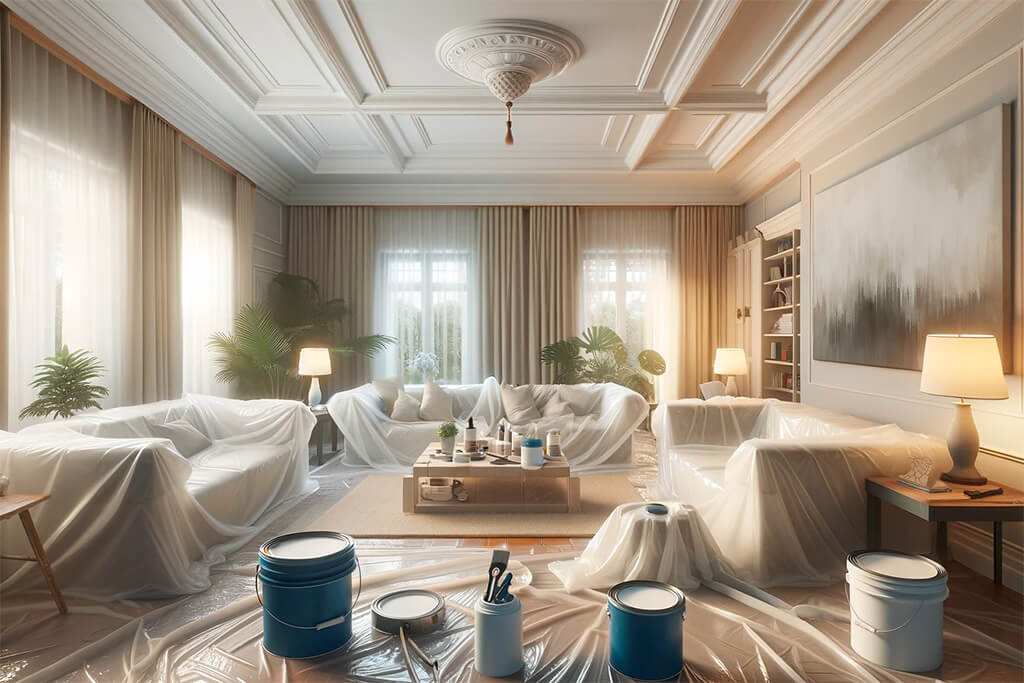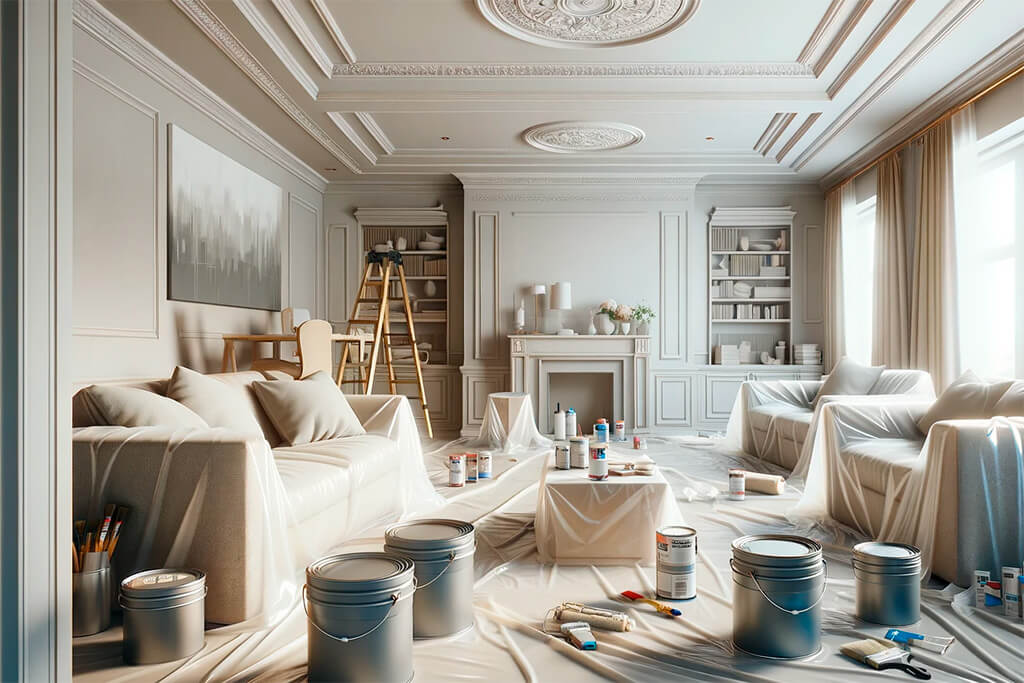In the realm of home design, popcorn ceilings have been around the block a few times, known for their distinctive texture that resembles—you guessed it—popcorn. This style soared in popularity from the 1950s through the 1980s, primarily because it was a budget-friendly way to mask ceiling imperfections and enhance soundproofing. But here’s the clincher: these ceilings, like any other component in your home, require maintenance, and a fresh coat of paint can do wonders.
Why paint them, you ask? Well, over time, these textured surfaces can collect dust and turn yellowish, losing their initial appeal. A new coat of paint not only refreshes the look but also reinforces the texture, preventing it from crumbling and shedding.

Understanding Popcorn Ceilings
Popcorn ceilings, sometimes humorously referred to as “stuccoed” or “acoustic” ceilings, have a unique place in home construction. They are typically made by spraying a mixture that might include styrofoam or other materials to create that characteristic bumpy texture. This texture has its perks, notably in sound dampening, which made it a hit in homes and apartment buildings.
However, they’re not without their pitfalls. For instance, if your popcorn ceiling predates the 1980s, there’s a risk it might contain asbestos—a serious health hazard if disturbed. Therefore, it’s crucial to have older ceilings tested before embarking on any renovation work.
Preparing to Paint a Popcorn Ceiling
Before you start, gathering the right tools and preparing the area is paramount. Here’s a checklist:
- Popcorn ceiling paint roller (preferably with a thick nap)
- High-quality ceiling paint
- Safety gear (goggles, mask)
- Drop cloths and painter’s tape
- Ladder
- Putty knife and joint compound for repairs
Start by clearing the room or at least centralizing and covering furniture. Drop cloths are a must to catch the inevitable drips and splatters. Inspect the ceiling for any damage or cracks, and use the joint compound to make necessary repairs. Let it dry thoroughly before proceeding to paint.

Choosing the Right Paint and Equipment
When selecting paint for a popcorn ceiling, a flat, white ceiling paint usually does the trick. It’s excellent for hiding imperfections and doesn’t draw unnecessary attention to the ceiling texture. In cases where the ceiling has seen better days, an alkyd or oil-based paint can provide better coverage and adhesion.
For the roller, opt for one with a thick nap, around ¾ inch or more, to effectively cover the textured surface. For those tackling larger areas, a paint sprayer can be a time-saver, though it requires careful handling and more extensive prep and cleanup.
Remember, the key to a successful popcorn ceiling paint job is all in the preparation and using the right tools for the task. By following these guidelines, you’ll ensure a revitalized ceiling that enhances the overall look and feel of your room.
Step-by-Step Guide to Painting Popcorn Ceilings
Painting a popcorn ceiling can seem daunting at first, but with the right approach, it’s quite manageable. Here’s how you can achieve a professional-looking finish:
- Prepare the Room: Begin by removing furniture or grouping it in the center of the room and covering it with drop cloths. It’s crucial to protect your furnishings from drips and splatters. Secure the perimeter of the ceiling with painter’s tape where it meets the walls. This helps to maintain clean lines and avoid unwanted paint on your walls.
- Inspect and Repair: Examine your ceiling closely for any damage. Popcorn ceilings can hide imperfections, but it’s important to patch any cracks or peeling areas with joint compound. Allow it to dry completely and sand lightly for a smooth surface.
- Safety First: Wear protective gear, including a mask and safety goggles. This is not just to keep the paint out of your eyes and lungs, but also to protect against any loose texture particles.
- Priming: If the ceiling has stains or hasn’t been painted in a long time, applying a primer is a good idea. Primer ensures better adhesion of the paint and extends its durability.
- Choosing the Paint: A flat, white ceiling paint is recommended. This type of paint hides imperfections and minimizes reflection, which is particularly important for textured surfaces like popcorn ceilings.
- The Right Roller: Use a roller with a thick nap to ensure you get into all the textured crevices of the ceiling. Load the roller evenly with paint, and apply it to the ceiling using gentle, even strokes. Avoid pressing too hard as it can dislodge the texture.
- Second Coat Consideration: After the first coat dries, assess whether a second coat is necessary. This will depend on the paint’s coverage and the ceiling’s initial condition.
- Cleanup: Once finished, carefully remove the painter’s tape and clean up any spills or splatters. Proper cleanup ensures a neat, professional finish.

Tips and Tricks
Throughout my career in renovation, I’ve learned several valuable tips for dealing with popcorn ceilings:
- Gentle Touch: Apply paint gently. Aggressive rolling can pull down the texture, creating a patchy look.
- Moisture Control: If using water-based paint, avoid over-saturating the roller. Too much moisture can weaken the popcorn texture.
- Overlap Wisely: Slightly overlapping your roller strokes helps ensure even coverage and prevents streaking.
- Sprayer Option: For larger areas, a paint sprayer can be efficient. Just remember, it requires thorough masking and covering of the room to protect against overspray.
- Adequate Lighting: Good lighting is essential. It helps in identifying uneven coverage or missed spots.
- Final Inspection: After the paint dries, inspect the ceiling with a flashlight. This can reveal any areas that may need touch-ups.
In renovating, as in life, attention to detail and a methodical approach can yield remarkable results. Painting popcorn ceilings is no different. With these steps and tips, you’re well-equipped to tackle this project and achieve a ceiling that’s not just functional, but visually appealing as well.

Maintaining Your Popcorn Ceiling
Keeping your popcorn ceiling in pristine condition after a fresh paint job is less about hard graft and more about regular, gentle care. Here’s what you need to know:
- Routine Cleaning: To prevent dust and cobwebs from settling in, regular cleaning is key. Use a vacuum with a soft brush attachment, or a duster with a long handle. Be as gentle as a breeze, rough handling can damage the texture.
- Spot Cleaning for Stains: If you spot a stain, tackle it with a light touch using a damp sponge. It’s crucial to avoid soaking the texture, as popcorn ceilings don’t take kindly to water.
- Timing Repaints: Your popcorn ceiling might need a new coat of paint every 5 to 10 years, depending on environmental factors and the ceiling’s exposure to sunlight. When it begins to look a tad tired or discolored, that’s your cue.
- Consider Removing the Texture: Trends evolve, and the desire for a smooth ceiling might lead you to consider removing the popcorn texture. This is a messy and potentially hazardous task, especially in older homes where asbestos might be present. Professional assessment is advised.
FAQ Section
Yes, indeed. With careful preparation and the right painting tools, you can rejuvenate a popcorn ceiling without scraping off the texture.
A flat, white ceiling paint is generally the best choice. It conceals flaws and avoids drawing attention to the texture with excessive sheen.
The secret lies in using a soft roller and applying the paint with a gentle hand. Heavy-handed painting can cause the texture to flake and fall off.
Yes, you can use a sprayer, especially for larger areas. It demands a steady hand for even coverage, but it can significantly speed up the process.
Generally, it takes a few hours to dry to the touch. However, waiting a full day before applying a second coat or rearranging the room is prudent.
